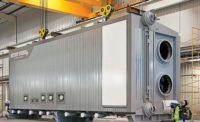
FIGURE 1 Newer design fins such as
AeroSeg serrated fins can increase efficiency of economizers and
HRSGs.
Insist on the old, familiar specifications for equipment, and you can look forward to the old, lower efficiencies, too.
I half expect some of the engineering specifications I read to end with “May the Force be with you,” or to call for a “groovy” economizer; the specifications seem to have been written in the 1970s and just re-used over the years. I am being facetious, but the point is that specifications for heat recovery equipment need to reflect the current technology and state of the art. Specifications that have simply been handed down over years will actually hinder design and do not lead to the most cost-effective and efficient heat transfer products.

Figure 2
This article very briefly highlights a few areas of improvement which can substantially lower capital costs as well provide units with the highest efficiency.
FIRETUBE BOILERS
Shortly after the introduction of firetube boilers, it became industry standard to rate them in terms of boiler horsepower (bhp) and to base this rating on the fire-side heating surface. Coal-fired boilers used at that time were supposed to have at least 10 sq ft/bhp of fire-side surface.With the advent of cleaner fuels and improved boiler designs, this “standard” changed to 5 sq ft/bhp in the 1960s. This standard, canonized in specifications, has become the de facto standard that (to date) determines the surface area a firetube boiler needs.
Improvements in enhanced tubes that are now available for the convective sections of firetube boilers allow for highly efficient heat transfer. Internally enhanced ribbed tubes, which have 25% more fireside surface area than a plain tube, can transfer 80% more heat than a plain tube due to heat transfer characteristics being fundamentally modified. Boilers with efficiency exceeding 81% utilizing these X-ID® tubes can have a fire-side heating surface are of 3.3 sq ft/bhp or lower, and have been in successful operation for years.
Complying with the 5 sq ft/bhp specification forces manufacturers to add surface area inside the boiler - uneconomically and inefficiently. A two-pass boiler with an economizer will provide a higher efficiency and lower cost than a four-pass boiler.
BOILER ECONOMIZERS
Bare tube vs. finned economizers. Many specifications call for bare tube economizers for coal-fired boilers, or sometimes even for other less fouling fuels. While customer concerns are justified, finned economizers have been proven to perform well even downstream of PRB coal-fired boilers. The key in designing finned economizers for fouling applications is appropriate fin density, fin height, and clear spacing between fin tips.Note that an economizer with just 2 fins/in. on a 2 in. O.D. tube will still have five times more surface area than a bare tube economizer, leading to a significantly more economical unit.
Fin density and tube layout. It is not uncommon to see economizer specifications specify finned tubes with 4 fins/in. on an inline layout, even for clean-burning fuels like natural gas. These specifications were probably written before serrated fins were even developed! Staggered tube arrangements provide significantly more heat transfer than an inline layout.
Furthermore, serrated fins provide better performance economically as compared to solid fins. Newer generations of fins, like the AeroSeg® fins, provide even better performance than regular serrated fins. Take advantage of these newer technologies to lower the cost and weight of economizers.

TABLE 1 Comparison of weight and
surface area reductions.
Table 1 shows a comparison of weight and surface area reductions by using proven designs vs. those typically specified. Note that the gas-side pressure drop is the same for all the designs shown.TB

